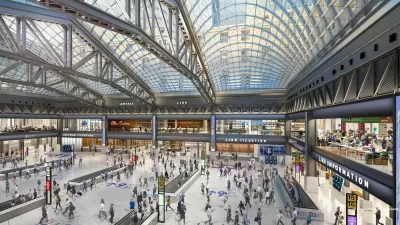Sacramento's downtown train station recently relocated its tracks to accommodate new transit oriented development - but the long, winding walk from depot to platform has presented problems for passengers, including a fatal heart attack on day one.
Tony Bizjak explains why what used to be a simple walk across one or two train tracks and one light rail track from depot and bus docks to Amtrak Capitol Corridor, San Joaquin and long-distance trains to Chicago and Seattle is now a five-minute, winding walk including a new tunnel with ramps.
"The city and Union Pacific say they built the new tracks, tunnels and platforms to reduce freight and passenger train congestion and to open space for development in the largely empty railyard." This first phase of construction of a federally-funded Intermodal facility, and associated mixed-use development, is being called the "Path to Progress" [PDF].
Some infirm passengers said the five-minute walk up and down ramps to the trains was too long. Other passengers complained that the temporary winding path through a construction zone was confusing. Some commuters missed their trains. And one man collapsed of an apparent heart attack" (and died).
Passengers clearly were not happy with the diagonal walk through the vacant railyard (slated for development) and then descending into the tunnel and walking up to the platform.
"This remodel seems to make the process harder with no tangible benefit," said Commuter Zak Frieders, who missed his train the first day when his light-rail train arrived too late.
"It seems like it is all tied up with the politics of the railyard development."
Thanks to David McCoard
FULL STORY: Train depot scrambles to fix issues on new tracks

Planetizen Federal Action Tracker
A weekly monitor of how Trump’s orders and actions are impacting planners and planning in America.

Chicago’s Ghost Rails
Just beneath the surface of the modern city lie the remnants of its expansive early 20th-century streetcar system.

San Antonio and Austin are Fusing Into one Massive Megaregion
The region spanning the two central Texas cities is growing fast, posing challenges for local infrastructure and water supplies.

Since Zion's Shuttles Went Electric “The Smog is Gone”
Visitors to Zion National Park can enjoy the canyon via the nation’s first fully electric park shuttle system.

Trump Distributing DOT Safety Funds at 1/10 Rate of Biden
Funds for Safe Streets and other transportation safety and equity programs are being held up by administrative reviews and conflicts with the Trump administration’s priorities.

German Cities Subsidize Taxis for Women Amid Wave of Violence
Free or low-cost taxi rides can help women navigate cities more safely, but critics say the programs don't address the root causes of violence against women.
Urban Design for Planners 1: Software Tools
This six-course series explores essential urban design concepts using open source software and equips planners with the tools they need to participate fully in the urban design process.
Planning for Universal Design
Learn the tools for implementing Universal Design in planning regulations.
planning NEXT
Appalachian Highlands Housing Partners
Mpact (founded as Rail~Volution)
City of Camden Redevelopment Agency
City of Astoria
City of Portland
City of Laramie



























